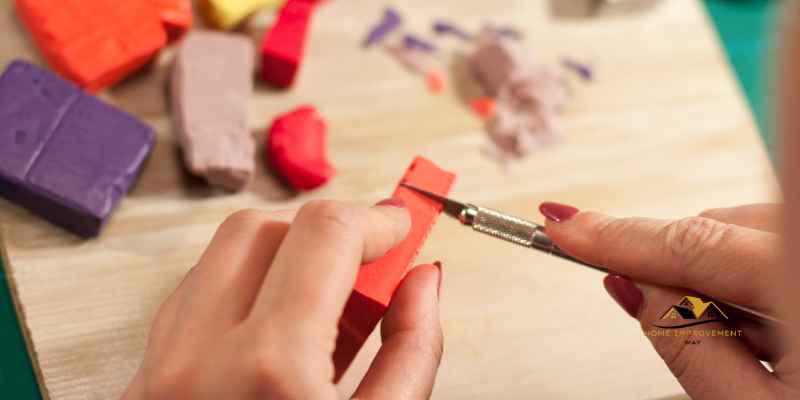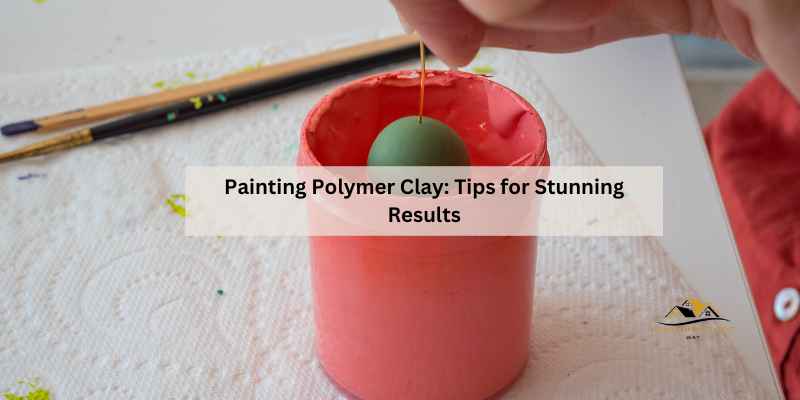To paint polymer clay, use acrylic paints for excellent coverage and easy custom color mixing. Painting polymer clay allows for endless artistic possibilities and creative expression.
Acrylic paints adhere well to polymer clay surfaces and can be applied before or after baking, providing a durable and vibrant finish. Experimenting with different painting techniques such as shading, antiquing, and dry brushing can enhance the visual appeal of polymer clay creations.
Sealing acrylic paint on polymer clay ensures long-lasting results and protects the painted surface from wear and tear. By following proper painting and sealing techniques, artists can achieve stunning and professional-looking polymer clay artworks that showcase their unique style and creativity.
Types Of Polymer Clay Painting
When it comes to painting polymer clay, there are various types of painting techniques and mediums that can be used to enhance the appearance of polymer clay creations. Understanding the different types of polymer clay painting methods can help artists achieve the desired effects and bring their creations to life. Let’s explore the various types of polymer clay painting and the techniques associated with each type.
Acrylic Paints
Acrylic paints are a popular choice for painting polymer clay due to their versatility and durability. These paints adhere well to polymer clay surfaces and provide excellent coverage. They can be easily mixed to create custom colors, allowing for endless possibilities in artistic endeavors.
Inks
Inks are another option for painting polymer clay, offering a translucent and vibrant color effect. They can be used to create intricate patterns and designs on polymer clay surfaces, adding depth and dimension to the final piece.
Mica Powders
Mica powders are finely ground pigments that can be mixed with various mediums to create a shimmering, metallic effect on polymer clay. They can be applied dry or mixed with a binder to create a paint-like consistency, allowing for a range of artistic possibilities.
Resin
Resin can be used to create a glossy, durable finish on polymer clay creations. It can be tinted with pigments or dyes to add color, and it provides a protective layer that enhances the visual appeal of the finished piece.
Tips For Painting Polymer Clay
To achieve the best results when painting polymer clay, it’s important to use water-based acrylic paints, as they adhere well to the clay surface and offer excellent coverage. Before painting, it’s advisable to test a hidden section of the project first and allow it to dry completely to ensure the desired outcome.
Additionally, acrylic paints can be easily mixed to create custom colors, providing endless possibilities for artistic endeavors.
Choosing The Right Paints
When painting polymer clay, use acrylic paints for excellent adhesion and coverage. Experiment with mixing colors for unique shades.
Priming The Clay
Before painting, consider priming the clay with a layer of white acrylic paint to ensure a smooth base.
Applying Washes
Create depth and dimension by applying washes of diluted acrylic paint over the polymer clay surface.
Antiquing For A Vintage Look
Achieve a vintage look by antiquing the polymer clay with dark acrylic paint and gently wiping off the excess for an aged effect.
Dry Brushing Techniques
Utilize dry brushing techniques by lightly brushing a small amount of paint over raised areas to highlight textures.
Top Coats And Finishing
Seal your painted polymer clay with a clear varnish or glaze to protect the finish and add a professional touch.
Painting With Metallics
Enhance your polymer clay creations by using metallic acrylic paints for a shimmering and eye-catching effect.
Eye Painting Technique
Master the art of eye painting on polymer clay by practicing precision and detail with small brushes and fine-tipped tools.
Painting Polymer Clay Before Baking
Applying eyeshadow on polymer clay before baking can create unique effects and shading. Simply use a soft brush to gently apply eyeshadow onto the clay surface.
Chalk pastels can be a great option for adding color to polymer clay. Use a soft brush to apply the pastels onto the clay surface, then blend for a smooth finish.
Alcohol inks offer vibrant colors and can be used on polymer clay. Apply the inks using a brush or dropper, allowing for interesting color effects and designs.
It’s important to clean your brushes thoroughly between colors when painting polymer clay. Use a gentle brush cleaner or soap and water to maintain the quality of your tools.
Before baking your painted polymer clay, ensure it’s not sticky by lightly touching the surface. If it feels tacky, bake it a bit longer to ensure a proper finish.
After baking, your painted polymer clay will have a durable finish that can be further enhanced with a sealant. Enjoy your beautifully painted creations!

Painting Polymer Clay After Baking
When it comes to creating vibrant and colorful polymer clay pieces, the process doesn’t end after shaping and baking. Painting polymer clay after baking allows for a myriad of possibilities to enhance and personalize your creations. Whether you’re a seasoned polymer clay artist or just starting out, mastering the art of painting polymer clay can take your creations to the next level.
Preparing The Surface
Before painting polymer clay, it’s crucial to prepare the surface to ensure proper adhesion and a smooth finish. Ensure that the baked polymer clay piece is free from any dust, dirt, or oils by gently wiping it with a soft cloth or using a small brush to remove any debris.
Choosing The Right Paints
When it comes to painting polymer clay, choosing the right paints is essential for achieving the desired results. Water-based acrylic paints are highly recommended for their excellent adhesion to polymer clay surfaces and their ability to provide vibrant and durable colors. Additionally, acrylic paints can be easily mixed to create custom shades, offering endless creative possibilities.
Testing For Adhesion
Before applying the paint to the entire surface, it’s important to conduct a small adhesion test on a discreet area of the polymer clay piece. This will ensure that the paint adheres well and doesn’t peel or flake off after drying. After applying the paint, allow it to dry completely before assessing its adhesion to the polymer clay.
Sealing The Paint
Once the paint has dried and the desired colors have been achieved, it’s essential to seal the painted polymer clay to protect the colors and provide a glossy or matte finish. A clear acrylic sealer or varnish specifically designed for polymer clay can be applied using a soft brush or spray to ensure the longevity and durability of the painted surface.
Final Touches
After sealing the paint, adding final touches such as embellishments, glazes, or additional layers of paint can further enhance the overall appearance of the polymer clay piece. These final touches can add depth, texture, and visual interest to the painted surface, elevating the artistic impact of the finished creation.
Common Questions About Painting Polymer Clay
Painting polymer clay raises questions about suitable paints and timing. Acrylic paints, known for their adherence and versatility, are recommended for coloring polymer clay. It’s best to paint after curing, using water-based acrylics, and testing a hidden section beforehand. Sealing the paint post-application ensures a lasting finish.
Painting polymer clay is a fun and creative way to personalize your sculptures, wall hangings, jewelry, and more. However, there are some common questions that arise when it comes to painting polymer clay. In this blog post, we will explore some of these questions and provide you with helpful answers and tips.
What Kind of Paint Can be Used on Polymer Clay?
One of the most common questions about painting polymer clay is what kind of paint can be used. The answer is that acrylic paints are the best option. These paints adhere well to polymer clay surfaces and provide excellent coverage. Additionally, they can be easily mixed to create custom colors, allowing for endless possibilities in your artistic endeavors.
Should You Paint Polymer Clay Before or After Baking?
Another common question is whether you should paint polymer clay before or after baking. The answer is that oven-bake clay can be painted after curing. We recommend using water-based acrylic paints. Before painting the piece, test a hidden section of the project first. Apply paint and allow it to dry completely.
How Do You Seal Acrylic Paint on Polymer Clay?
Sealing acrylic paint on polymer clay is important to protect your artwork from scratches and damage. The best way to seal acrylic paint on polymer clay is to use a water-based varnish or sealant. Apply it in thin coats, allowing each coat to dry completely before applying the next one.
Can You Paint Polymer Clay Without Baking?
Lastly, you may wonder if you can paint polymer clay without baking it. The answer is no. Polymer clay needs to be baked to harden and set properly. Once it is baked, you can paint it with acrylic paints and seal it with a varnish.
In conclusion, painting polymer clay is a fun and creative way to personalize your artwork. By using acrylic paints, painting after baking, sealing the paint, and baking the clay first, you can create beautiful and long-lasting pieces of art.

Frequently Asked Questions
What Kind Of Paint Can Be Used On Polymer Clay?
Acrylic paints are ideal for painting polymer clay, offering good adhesion and coverage. They can be easily mixed for custom colors.
Should You Paint Polymer Clay Before Or After Baking?
For polymer clay, paint after baking with water-based acrylic paints for best results. Test on a hidden section first.
How Do You Seal Acrylic Paint On Polymer Clay?
To seal acrylic paint on polymer clay, use a water-based acrylic sealer for a protective finish.
Can You Paint Polymer Clay Without Baking?
Yes, you can paint polymer clay without baking by using water-based acrylic paints. Apply and let dry.
Conclusion
Discover the endless possibilities of painting polymer clay with acrylic paints. Create custom colors and bring your artistic vision to life with ease. Whether before or after baking, acrylic paints adhere well and provide excellent coverage. Unleash your creativity and elevate your polymer clay creations with the right painting techniques.


